Bishkek to Jalalabad: Fear and Loathing
27 August, 2008, 05:34 am in "Kyrgyzstan"
We didn't have to wait long to have a full taxi to Jalalabad (and Osh). One guy, a bicyclist from Slovenia (whose bike was in Sary Tash while he tried (unsuccessfully) to get a visa to China) was already waiting. A few minutes later, the taxi mafia brought another passenger, a 16 year old boy with a small dog. With 4 passengers, we were able to leave.
Once out of Bishkek, we turned south towards the mountains. It might have been an enjoyable ride since we drove through high, steep mountains and impressive gorges, seeing lakes and rivers. Unfortunately, we couldn't enjoy the scenery because our driver was a maniac. He couldn't handle the thought of having a car in front of him so he'd whip around them towards oncoming traffic, honking wildly for the cars he was passing to make enough space to let him in before we were flattened by the oncoming traffic. He'd speed over rough parts of the road sending us flying upwards as he hit a bump. I noticed the ceiling of the car looked dented as if some previous passenger had been sent pounding into it. He also liked to speed up going around bends so he could hear the sounds of his tires screeching as they skidded sideways. When he did this, the 3 of us in the back would be thrown into one another. Eventually, we ended up grasping door handles and dry cleaning hooks for the duration of the trip. We had to wait at the top of one pass because the tunnel was one way. After getting through the tunnel, our driver passed all the cars that had been in front of us in line, as well as several cars that had the nerve to pass us.
There was a pretty stretch as we drove along side the Naryn River which was deep turquoise instead of the muddy gray color it is near Naryn. We reached the outskirts of Jalalabad around 5:30 PM, grateful to still be alive. The driver dropped us off at the edge of town instead of the center but we were too relieved to be out of his car to try to persuade him to take us into town. Instead we paid for another taxi into town and booked a room in the Hotel Molmol, a decaying Soviet monster with leaking faucets, damaged doors, and deteriorating flooring. It did have a balcony, though, and was sufficient for the night.
We took a brief walk around Jalalabad looking for a cafe but mostly saw stores advertising electronics, airline ticket offices, and photocopy shops. We also noticed, for being a religiously conservative town, there were a lot of stores just selling alcohol (as well as a lot of drunk people).
Not very impressed, we ate dinner and went back to the hotel where very soon the electricity went out. So, we went to bed. This morning, the electricity was on but there was no water. Fortunately this must be a frequent occurrence since there was a stock of bottles in the bathroom filled with water.
We were going to have breakfast in the hotel cafe but while we were waiting, Rowshan made the mistake of politely saying "Salam Alekham" to a man at the counter who had been staring at us. He turned out to be both drunk and an a-hole. Her replied (in Russian) "What's with your hair?" Rowshan jokingly responded that he just needed an "Al Kapak" Kyrgyz hat like the guy was wearing. Then the guy looked at me and asked Rowshan (in Russian), "Yours?" At first I thought he was saying something in Kyrgyz that I didn't understand because it was just so rude. Then I pointed to Rowshan and myself and said in Russian "husband and wife". He said he didn't understand, gestured us to come closer and when we did he tried to kiss me. Before he got close enough, Rowshan had thrown him against the wall and began yelling at him in Azeri (somewhat understandable to Kyrgyz... and if not, Rowshan's intonation was). One of the women working at the cafe tried to separate them. I eventually steered Rowshan out of the room and we got our stuff and went straight to the bus station (without breakfast). On the road we passed cafes where people were sitting, already working on the first bottle of vodka of the day.
We caught a minibus to Bazaar Korgon just as it was leaving. A little ways up the road, Rowshan started yelling at the guy sitting next to him, an old toothless man who had been persistently jabbing at him with his elboe. The driver stopped and the old man said, "I just wanted to know where he was from." Rowshan replied, "Then ask! Don't hit me! I'm not a horse!" A woman in front of me excused the man saying, "He's old." Rowshan, however, could smell the alcohol on the man's breath. I turned to the man and said, "By the way, he is from Iran." After the outburst, the old man was friendlier towards Rowshan, even moving closer to be crushed against him when another passenger boarded and sat in the same seat with them.
Rowshan said, "No wonder our guide and porters in Karakol hate people from Jalalabad!"
Once out of Bishkek, we turned south towards the mountains. It might have been an enjoyable ride since we drove through high, steep mountains and impressive gorges, seeing lakes and rivers. Unfortunately, we couldn't enjoy the scenery because our driver was a maniac. He couldn't handle the thought of having a car in front of him so he'd whip around them towards oncoming traffic, honking wildly for the cars he was passing to make enough space to let him in before we were flattened by the oncoming traffic. He'd speed over rough parts of the road sending us flying upwards as he hit a bump. I noticed the ceiling of the car looked dented as if some previous passenger had been sent pounding into it. He also liked to speed up going around bends so he could hear the sounds of his tires screeching as they skidded sideways. When he did this, the 3 of us in the back would be thrown into one another. Eventually, we ended up grasping door handles and dry cleaning hooks for the duration of the trip. We had to wait at the top of one pass because the tunnel was one way. After getting through the tunnel, our driver passed all the cars that had been in front of us in line, as well as several cars that had the nerve to pass us.
There was a pretty stretch as we drove along side the Naryn River which was deep turquoise instead of the muddy gray color it is near Naryn. We reached the outskirts of Jalalabad around 5:30 PM, grateful to still be alive. The driver dropped us off at the edge of town instead of the center but we were too relieved to be out of his car to try to persuade him to take us into town. Instead we paid for another taxi into town and booked a room in the Hotel Molmol, a decaying Soviet monster with leaking faucets, damaged doors, and deteriorating flooring. It did have a balcony, though, and was sufficient for the night.
We took a brief walk around Jalalabad looking for a cafe but mostly saw stores advertising electronics, airline ticket offices, and photocopy shops. We also noticed, for being a religiously conservative town, there were a lot of stores just selling alcohol (as well as a lot of drunk people).
Not very impressed, we ate dinner and went back to the hotel where very soon the electricity went out. So, we went to bed. This morning, the electricity was on but there was no water. Fortunately this must be a frequent occurrence since there was a stock of bottles in the bathroom filled with water.
We were going to have breakfast in the hotel cafe but while we were waiting, Rowshan made the mistake of politely saying "Salam Alekham" to a man at the counter who had been staring at us. He turned out to be both drunk and an a-hole. Her replied (in Russian) "What's with your hair?" Rowshan jokingly responded that he just needed an "Al Kapak" Kyrgyz hat like the guy was wearing. Then the guy looked at me and asked Rowshan (in Russian), "Yours?" At first I thought he was saying something in Kyrgyz that I didn't understand because it was just so rude. Then I pointed to Rowshan and myself and said in Russian "husband and wife". He said he didn't understand, gestured us to come closer and when we did he tried to kiss me. Before he got close enough, Rowshan had thrown him against the wall and began yelling at him in Azeri (somewhat understandable to Kyrgyz... and if not, Rowshan's intonation was). One of the women working at the cafe tried to separate them. I eventually steered Rowshan out of the room and we got our stuff and went straight to the bus station (without breakfast). On the road we passed cafes where people were sitting, already working on the first bottle of vodka of the day.
We caught a minibus to Bazaar Korgon just as it was leaving. A little ways up the road, Rowshan started yelling at the guy sitting next to him, an old toothless man who had been persistently jabbing at him with his elboe. The driver stopped and the old man said, "I just wanted to know where he was from." Rowshan replied, "Then ask! Don't hit me! I'm not a horse!" A woman in front of me excused the man saying, "He's old." Rowshan, however, could smell the alcohol on the man's breath. I turned to the man and said, "By the way, he is from Iran." After the outburst, the old man was friendlier towards Rowshan, even moving closer to be crushed against him when another passenger boarded and sat in the same seat with them.
Rowshan said, "No wonder our guide and porters in Karakol hate people from Jalalabad!"
Tash Rabat: No Horses at the Caravansaray
24 August, 2008, 03:30 am in "Kyrgyzstan"
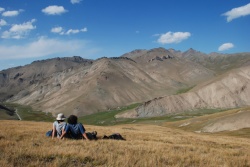 Day 1
Day 1Today we drove from Naryn to Tash Rabat going over another set of mountains and driving along a spectacular snow-capped range. The road is the main road from China and is frequented by large Chinese trucks. This is tolerable on the bumpy, potholed asphalt but when the road becomes gravel they kick up huge clouds of dust concealing the road as they pass.
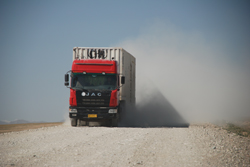
Tash Rabat is 15 km off the main road in a small river valley. From the hills, the area around the river is a puddle of green following the lowest parts of the hills. The weather was beautiful when we arrived at the yurt camp.
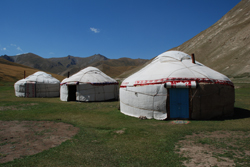
When we arrived, we learned there were no horses available. This was unfortunate because that is what people do around here. Instead, we walked to the caravansaray for which the area is named, Tash Rabat, the stone fortress.
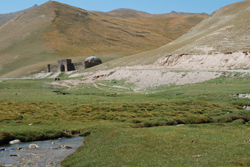
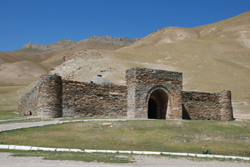
The ruins have been reconstructed but it still is an interesting structure of stone. It is built into the hill and the wall in the front is the true height of the building but as you walk towards the back, the wall gets to be only a couple feet high and you can climb up and walk on the roof.
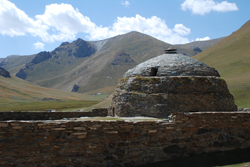

Inside it is a large structure with a hall with many rooms leading off it. In the back is a large domed area where there was a mosque.
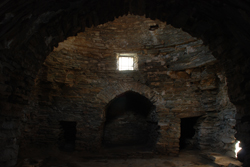
Off of that were some general sleeping dorms--long hallways with shelves for sleeping.
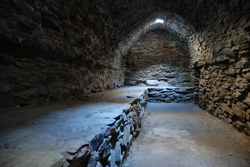
One part had a second story with more sleeping spaces. Most of the rest of the caravansaray were small rooms for wealthier patrons. There was a tunnel and a small dungeon.
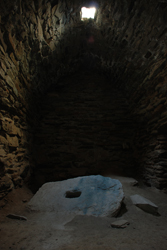
Since some of the rooms were dark, we came back after lunch with flashlights.
In the valley there seem to be a couple herds of yaks who wander around looking like the hippies of the bovine world. We climbed up a bit of one of the surrounding hills and watched eagles circling and listed to yaks grunting.
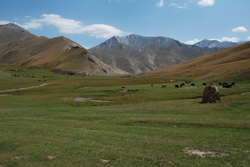
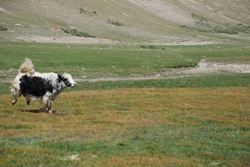
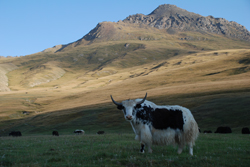
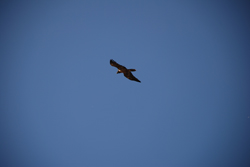
Rowshan decided to see how he would look with yak inspired facial hair.
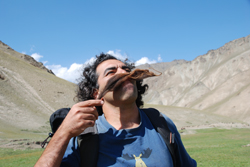
Even without horses, we had a pleasant walk admiring the view of the yurt camp and Tash Rabat below us.
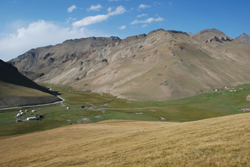
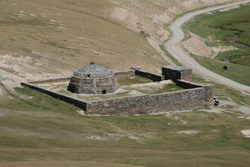
We did have to be careful where we sat because of the presence of a lot of yak dung.
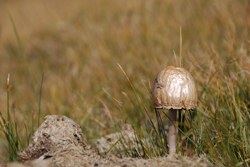
After our walk, we had a bath in the Russian sauna, powered by yak dung.
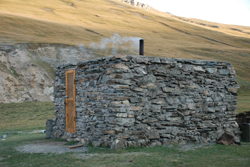
Then I relaxed in the yurt while Rowshan took photos outside. The yurt we are in has lots of shyrdaks as well as other decorations which will hopefully provide extra insulation.
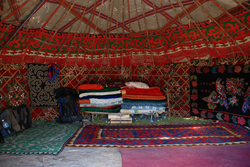
The family served dinner in a special guest dining room in their house.
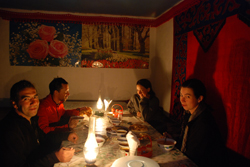
Day 2
The perfectly clear, star-filled night seemed to transform itself into a murky blur of clouds and rain by morning.
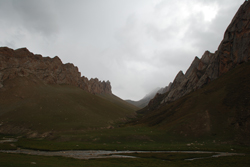
At breakfast we could see strong gusts of wind sending the thistle-down whipping in a perfect horizontal line across our vision. When Cholpan, the tourist camp owner's daughter, a very professional and intelligent 13 year old, came into the dining room to confirm our riding plans, we backed out.
Instead we opted to try to make it to Bishkek. I do want to say a few words about Cholpon. She was the one who greeted us and seemed to organize everything. She asked us about our meal times, what our plans were, if we wanted a Russian bath... When we went to the caravansaray, she found the caretaker and had her open the gate and then gave us a little tour. We were all very impressed. She also managed to speak more English than many of the people we've met. We were all very impressed that she could be so responsible at 13.
We made a stop at Koshoy Korgon where there were ruins of an ancient fortress. The mud walls were rather shapeless blobs that made a square shape on the ground.
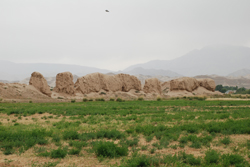
There was a nice little museum which had information about the history of the region (in Kyrgyz, Russian, and English) and a display of artifacts found at the site. There was a display about Manas as well as a yurt skeleton and ethnographic pieces. There was also a model of what the fortress may have looked like before it became melted piles of mud. From there we continued on to Naryn, passing people harvesting in their fields and others transporting animals.
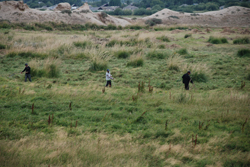
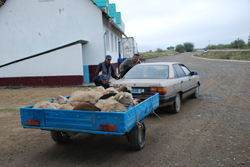
Our driver agreed to take us to Bishkek so after a stop in Naryn for him to inform his wife, we continued through the mountains, passing a stunning wall of red stone on our way out of town.
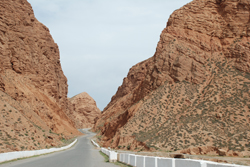
The weather got warmer and clearer as we progressed on our way North. After a lunch stop with rather disappointing food at Cafe Vizit (which we'd eaten at several times before and had good food but this time they couldn't do fried laghman and their beshparmak was made from ramen noodles which would have been very hard to eat with 5 fingers), we continued towards Bishkek passing numerous odd concrete monuments of animals (as well as a giant hat), some beautiful vistas, and lots of mountains.
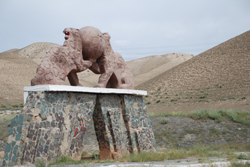
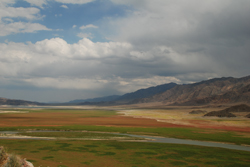
[ View 1 Comments
|
]
Evening in Naryn
22 August, 2008, 03:30 am in "Kyrgyzstan"
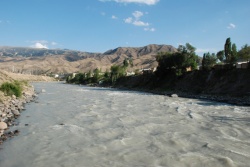 The road to Naryn passed through another layer of mountains. I usually think about mountains as kind of being a row that you pass over and then end up on the other side. Here in Kyrgyzstan, you go over a line of mountains and then there are more. You pass over those and find even more. We got into Naryn during the CBT lunch break so sat for an hour with our bags on their doorstep.
The road to Naryn passed through another layer of mountains. I usually think about mountains as kind of being a row that you pass over and then end up on the other side. Here in Kyrgyzstan, you go over a line of mountains and then there are more. You pass over those and find even more. We got into Naryn during the CBT lunch break so sat for an hour with our bags on their doorstep.Naryn seems like an ordinary town-- a main street, Lenina, runs down the center with brick buildings of several stories, a hotel, police station, various markets, some restaurants, a fabric store which changes dollars, and Internet places. It has a university and official looking buildings but, looking at the number of people on the street, you'd think it was smaller than Kochkor. Maybe after school starts it will be a bit more lively.
On one side there are dry greenish hills.
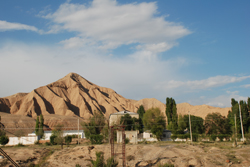
On the other side is the river--churning gray-- and dirt hills of brown, tan and red. After settling into our guest house (an empty apartment), we met with Daniel and Louisa, 2 fellow travelers who we agreed to share the taxi up to Tash Rabat with, and had lunch at a mediocre restaurant. Then we walked up to CBT, finalized the taxi and headed back through town, stopping by a Shyrdak shop where we bought a small sample.
In the center we noticed an art gallery and went inside. It was closed, but a man standing outside opened the doors and turned on the lights for us. In the middle was a yurt, nicely decorated with shyrdaks, musical instruments, and other traditional items.
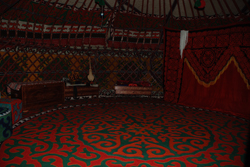
The gallery was made up of 3 rooms, each of whose walls were filled with paintings by Russian and Kyrgyz artists. Some were standard types of landscapes--scenes with yurts and people in traditional clothing, others were ethnographically inspired. Some were abstract and others were fantasy. There were some portraits, paintings of horses, black and white prints of etchings. There were also some ceramic pieces. However, the pieces in the gallery didn't seem to be in any particular order: not chronological, or stylistic for sure. Still, it was a surprisingly good collection and I enjoyed the variety.
Powered by My Blog 1.69. Copyright 2003-2006 FuzzyMonkey.net.
Created by the scripting wizards at FuzzyMonkey.net..
(Code modified by Rowshan Dowlatabadi)
Created by the scripting wizards at FuzzyMonkey.net..
(Code modified by Rowshan Dowlatabadi)

